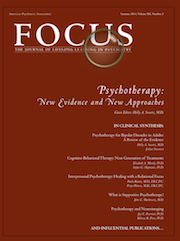Psychotherapy and Neuroimaging
Abstract
Technological advances in neuroimaging have enabled researchers to examine, in vivo, the relationship between psychotherapeutic interventions and markers of brain activity. This review focuses on two kinds of neuroimaging studies in psychotherapy: those that examine the patterns of brain activity associated with response to treatments and those that examine the changes that occur in brain activity during treatment. A general, hypothetical neural model of psychotherapy is presented, and support for the model is evaluated across anxiety disorders and major depression. Neuroimaging studies are broadly consistent in observing associations between response to psychotherapy and baseline activity in several key regions within the prefrontal cortex and limbic areas. These regions are involved in the generation and regulation of emotion, fear responding, and response to reward. Prepost examinations of change following psychotherapy also typically observe that psychological treatments for anxiety and depression can affect neural activity in these regions. Despite a general consensus that activity in these regions is associated with psychotherapy, substantial discrepancy persists regarding the precise direction of the observed relationships. Methodological challenges of the existing literature are considered, and future directions are discussed.



